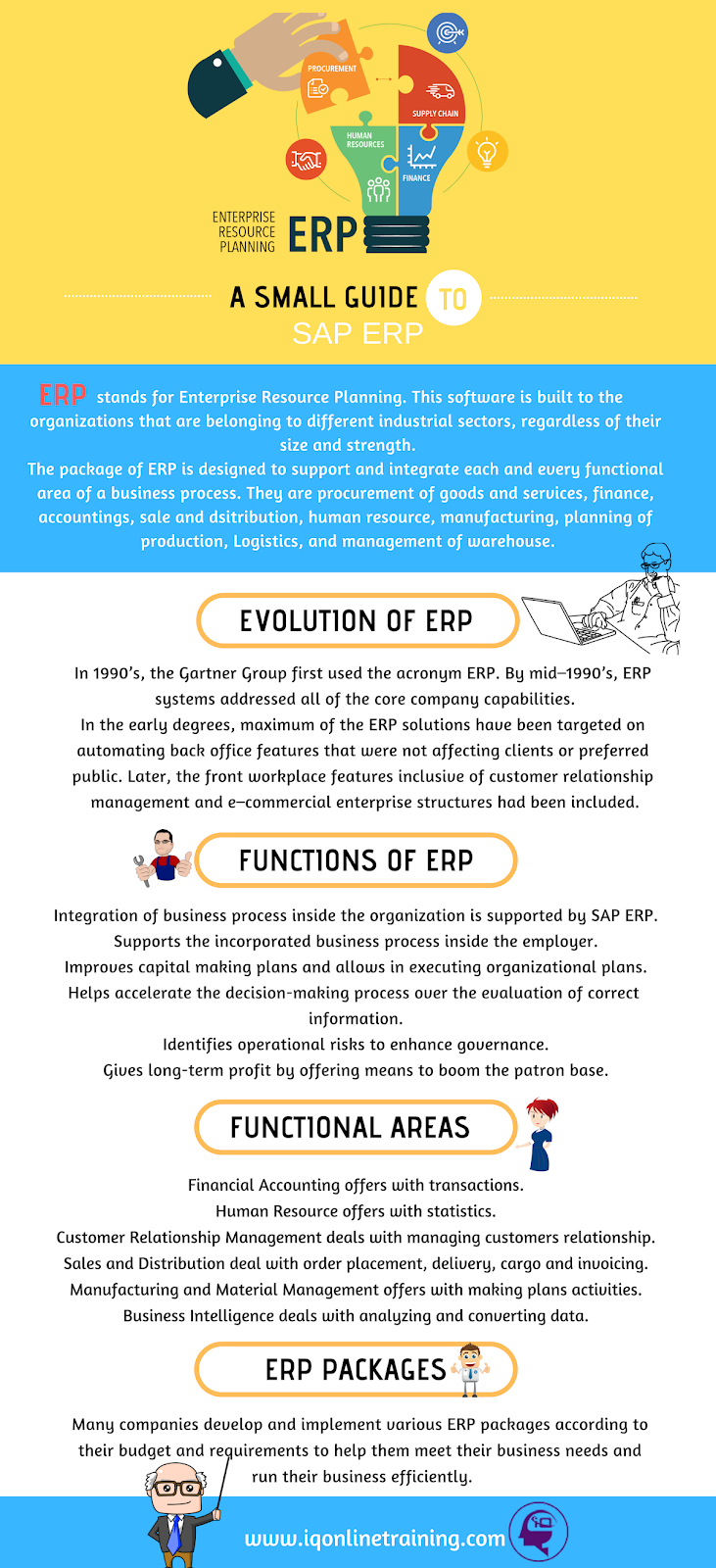20 SAP ERP INTERVIEW QUESTIONS AND ANSWERS 2018[LATEST]
A. In SAP ERP, ERP stands for “Enterprise Resource Planning”. ERP is defined as an integrated software solution used to manage the company’s resources. It also integrated all of the business management functions including planning, management of materials, manufacturing, purchasing, accounting, and more.
Q. Mention the different types of ERP used by organizations?
A. The types of ERP used by organizations are,
A. The types of ERP used by organizations are,
· SAP
· Baan
· JD Edwards (now owned by Oracle)
· Siebel
· PeopleSoft (now owned by Oracle)
Q. What are the Different Types of Modules in SAP?
A. The different types of Modules in SAP are as follows:
· FI (Financial Accounting)
· CO (Controlling)
· EC (Enterprise Controlling)
· TR (Treasury)
· IM (Investment Management)
· HR (Human Resource)
· SD (Sales and Distribution)
· MM (Materials Management)
· PM (Plant Maintenance)
· PP (Production Planning)
· QM (Quality Management)
· BW (Business Warehousing)
Q. How Many SAP Sessions Can Run Simultaneously?
A. You can run up to 6 sessions simultaneously for a particular client.
Q. What Does Transaction Refer to in SAP Terminology?
A. In terms of SAP, a transaction refers to the series of logically connected dialog steps in SAP and individuals can learn all about transaction while undergoing an SAP Course.
Q. Does SAP Act as a Database?
A. SAP doesn’t act as a database, but it’s a software application which allows users of databases like Oracle, SQL Server. To work with these databases, an SAP Certification is necessary.
Q. What are the Cons of Using SAP?
A. Following are some cons of using SAP
- It is an expensive solution
- Experienced employees are required to handle it.
- Implementation takes time.
- Understanding complex interfaces is not easy.
- It doesn’t have the capability to find the location of master data.
Q. Where are T-Code Name and Program Values Stored?
A. By using the code st11, a transaction table TSTC is viewed and also you can define a new T-Code by using the code se93.
A. The type of variables used will change based on the application.
- Characteristics variable
- Hierarchies
- Hierarchy Nodes
- Text
- Formulas
- Processing Types
- Replacement Path
- User entry/default type
Q. Mention what do you mean by datasets?
A. The data sets are sequential files processed on the application server. They are used for file handling in SAP.
A. The data sets are sequential files processed on the application server. They are used for file handling in SAP.
A. Variables are nothing but the parameters of a query. They are set in the parameter query definition. Until the queries are entered into the workbooks they are not filled with queries.
Q. Define the terms Meta Data, Master Data and Transaction Data?
A. Meta Data: It is a set of statistics about the information stored and it simplifies the setup with Meta Objects and offers an overview of the shape of the information.
Master Data: It refers to critical facts including consumer statistics, worker information, and substances to be had and so on. It is used as reference facts to streamline production and transport by using customer information in an efficient manner.
Transaction Data: It refers to information that keeps track of daily transactions.
A. The three most important stages of data mining are as follows:
- Initial Exploration
- Model building
- Deployment
A. The different layers found in the R/3 system are as follows:
- Presentation Layer
- Database layer
- Application layer
A. AWB stands for Administrator Workbench. It is a tool used to monitor, control and maintain every process. It is connected with data staging and business information warehousing.
A. Bex stands for Business Explorer which simplifies the method of locating reports, analyzing data and permitting a person to view reports in addition to execute queries. The queries may be labeled into respective roles while saved on the Bex browser. The setup includes Bex analyzer, Bex Map and Bex web.
Q. How does Domain Differ from Data Element?
A. Data Element is an intermediate item that is determined between a site and table kind even when Domain refers to distinctive attributes like length, type, and feasible cost range.
Q. What does ALE, IDOC, EDI, RFC stand for?
A. These abbreviations stand for:
· ALE: Application Link enabling
· IDOC: Intermediary documents
· EDI: Electronic data interchange
· RFC: Remote function call
Q. What is BDC? What Are the Methods Used in it?
A. BDC stands for Batch Data Communication and the different methods used in it are,
· Direct Input Method
· Batch Input Session Method
· Call Transaction Method
Q. Explain Business Content in SAP terms?
A. Business Content is defined as the models of information that are pre-defined or pre-configured. They are contained in an SAP warehouse.




Comments
Post a Comment